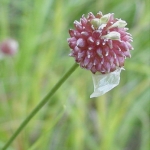| Common Name: |
Wild Garlic |
| Other Names: |
Society garlic, isihaqa, wilde knoffel |
| Botanical Name: |
Tulbaghia violacea |
| Genus: |
Tulbaghia |
| Family: |
Alliaceae |
| Native Location: |
S Africa (Eastern Cape, S KwaZulu/Natal) |
| Cultivation: |
Well-drained, rich soil in sun or partial shade. Frost-hardy plants usually survive outdoors in cold areas if given a sheltered position and mulched in winter. |
| Propagation: |
By seed sown when ripe or in spring; by division in spring. Seeds germinate quickly and seedlings soon reach flowering size. |
| Harvest: |
Leaves and bulbs are harvested as required and used fresh. |
| Height: |
45-60cm (18-24in) |
| Width: |
25cm (10in) |
| Variations: |
Silver Lace
syn. Variegata
Has white-striped leaves and larger flowers, 2-4cm (¾-1½in) long. |
|
| Hardiness: |
Z7 |
| Parts Used: |
Leaves, flowers, bulbs |
| Properties: |
An antiseptic, expectorant herb that lowers fevers and has laxative effects. |
| Medicinal Uses: |
Internally in folk medicine for colds, coughs, flu, asthma, tuberculosis, fevers, and cancer of the esophagus. Externally as a bath or wash for rheumatism, paralysis, and feverish illnesses, and as an enema for digestive problems. |
| Culinary Uses: |
Leaves and flowers are used in the same way as Chives (Allium schoenoprasum). Bulbs are used like scallions. |
| Bibliography: |
Encyclopedia of Herbs by Deni Brown Copyright © 1995, 2001 Dorling Kindersley Limited. pg 395 |

